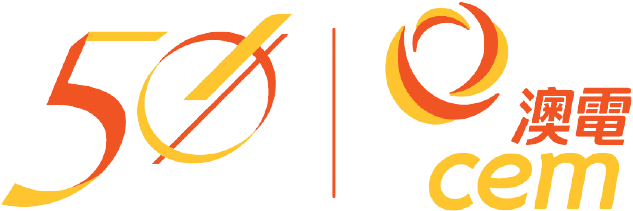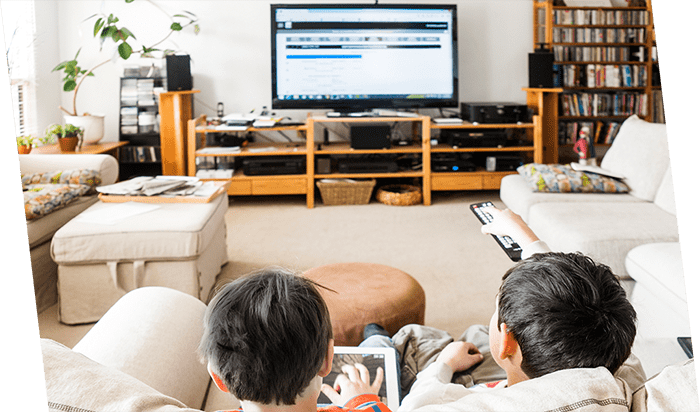
Living Room & Bedroom

Illumination
- Change to T8 or T5 energy efficient fluorescent tubes which are 10% to 30% more energy efficient.
- Change to LED bulbs. The power consumption and lifespan of LED bulbs are 1/10 and 40 times of incandescent light bulbs, respectively.
- Avoid installing halogen lamps more than needed. This causes temperature rise in rooms and thereby increases air-conditioning costs.
- Install appropriate dimmers to adjust brightness of the light to save energy.

Air-Conditioner
- Set thermostat at 24°C to 25°C for maximum comfort and energy efficiency.
- Adjust thermostat up by 1°C to 2°C before going to bed as the body temperature drops during sleep.
- Every 1°C increase can save 3% energy consumption.
- Use a fan in cooler days. It consumes only 5% to 10% of electricity used by air-conditioners.
- Clean the dust filters fortnightly can lower energy consumption by 5-15%.

Heater and Dehumidifier
- Keep windows and doors closed when heaters and dehumidifiers are in use.
- Keep area around heaters and dehumidifiers clean and free of obstructions for energy efficiency.
- Switch off heaters and dehumidifiers 15 to 30 minutes before leaving home.
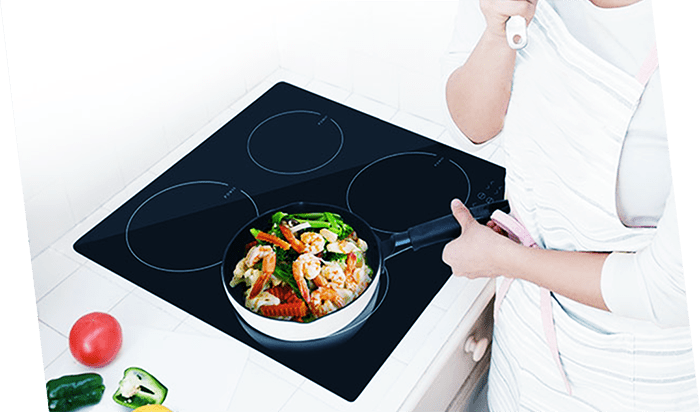
Kitchen

Refrigerator
- Set refrigerator to the recommended temperatures of 3°C for fresh food compartment and -18°C to -15°C for freezer.
- Cover liquids and wrap foods stored in refrigerator. Uncovered foods release moisture that requires additional loading to compressor.
- Don’t locate refrigerator under direct sunlight or near heat sources, e.g. ovens.

Microwave & Conventional Ovens
- Ensure frozen food to be thawed properly before cooking.
- Make use of the timer to avoid overcooking.
- Maximize the amount of food cooked in the least amount of time required, e.g. cook food that requires high temperature first, followed by making dishes that require progressively lower temperatures.

Other Kitchenware
- 30% to 50% more energy efficient.
- Don’t let electric kettle boil over and do keep its bottom clean.
- Cut food into smaller pieces before putting into blenders.
- Dust out all the crumbs from the bottom of toasters after use.
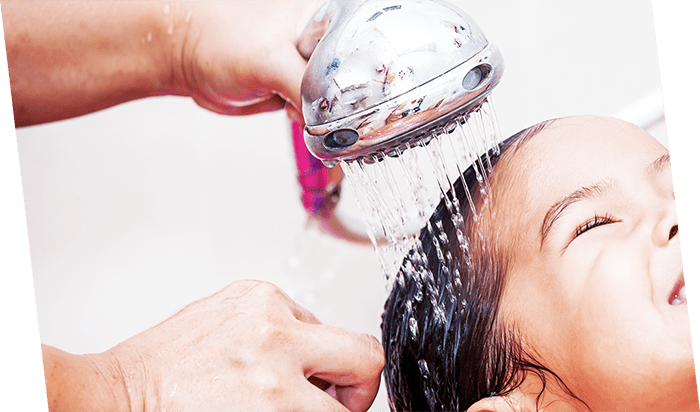
Bathroom & Utility Room

Electric Water Heater
- Take showers instead of baths to save up to 50% of energy.
- Set thermostat at a lower temperature to shorten heating time if only a small amount of hot water is needed.

Washing & Drying Machines
- Only use washing and drying machines with a full load.
- Use cold water for both washing and rinsing.
- Clean lint filters after each load to keep machines efficient.

Electric Iron
- Iron large batches of clothing at one time for energy efficiency.
- Switch off irons and use residual heat to finish items that require careful treatment, e.g. silky items.

Vacuum Cleaner
- Choose a model that is practical and suitable for floors or carpets at home. An all-purpose model using a lot of power may not be the best choice.
- Clean or replace dust bags regularly to keep appliances in good condition.

Office

Illumination
- Replace T12 or T10 fluorescent tubes with T8 or T5 energy efficient fluorescent tubes which are 10% to 30% more energy efficient.
- Replace incandescent light bulbs with LED light bulbs which are 90% more energy efficient.
- Install dimmers and lighting zone controls wherever possible to adjust brightness of or turn off the light in unoccupied areas.
- Install parabolic-type lighting reflectors to reflect sufficient light with fewer fluorescent tubes.

Office Equipment
- Select energy-efficient office equipment, e.g. photocopiers and laser printers that bear energy labels.
- Always switch off office equipment when they are not in use during non-office hours.

Water Heating
- Use heat pumps, high-efficiency electric water heaters and boilers.
- Keep hot water pipes as short as possible.

Heating, Ventilating & Air-Conditioning (HVAC) System
- Replace ageing HVAC equipment with new energy-efficient equipment.
- Set room temperatures to standard optimum temperature 24°C or 25°C.
- When outside conditions are suitable and the outdoor air is cool and dry enough, the outdoor air intake should be increased.
- Maintain cooling efficiency by regularly cleaning condenser tubes, cooling coils and air filters.

Building Envelope
- Install self-closing doors to non-air-conditioned spaces to reduce excessive infiltration and exfiltration.
- Install caulking or replace worn caulking around windows, doors or other infiltration or exfiltration areas.
- Install outdoor shading devices, add reflective film to windows and close interior shades such as curtains or blinds (preferably light colored) to reduce solar heat in summer.

Other Machinery & Equipment
- Adhere to the maintenance schedules recommended by manufacturers.
- Reduce the numbers of lifts or escalators in service during non-office hours.
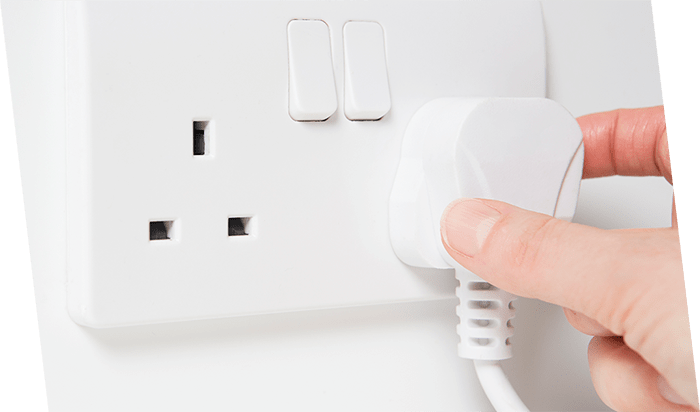
Safety Tips

Main Switch
- Check regularly to see that the main switch is in good condition.
- Label "ON" and "OFF" clearly.
- Be easy to reach without obstructions in an emergency.

Residual Current Devices (RCDs)
- Use RCDs to protect yourself from electric shock. They can automatically disconnect the electricity supply if an earth fault or a current leakage develops. They are especially important to be installed in kitchens, bathrooms and places where water is present.
- Test RCDs according to the manufacturer’s instructions regularly by pressing the button marked "T" or "Test".

Circuit Breakers / Fuses
- Choose correct rating and type.
- Label each circuit breaker or fuse to indicate which circuit it protects.
- Always replace the blown fuse the proper rating. Don’t substitute it with an object, such as a coin or paper clip.
- Know how to switch on/off circuit breakers safely.
- The circuit breaker trips off repeatedly when the appliance is plugged, there could be a fault on that circuit and you should seek assistance from an experienced electrician.

Socket Outlets
- Replace any broken or missing outlets and wall plates.
- Place safety caps in all unused outlets that are accessible to children.
- Do not use extension socket when the appliances exceed the maximum current rating.

Plugs
- Choose a square 3-pin 13 amp plug that complies with safety requirements and standards.
- Check the plugs for signs of damage or discoloration.
- Plugs should fit securely into outlets, don’t force a plug into an outlet if it doesn’t fit.

Cords
- Make sure cords are in good condition – no part of the cable is worn, split, cracked or frayed.
- Use electrical cords properly. Insert or remove plugs by grasping themselves instead of the cords.
- Don’t run electrical cords underneath carpets, rugs or furniture, near hot appliances or expose them to corrosive materials.
- When using a detachable cord, always unplug the appliance from socket outlet before detaching the cord from appliance.

Lighting
- Arrange regular check for damaged fittings, cords and connections.
- Don’t use bulbs that have higher wattage than the recommended size of fixture.
- Ensure outdoor lighting fittings and luminaries are weatherproof.
- Don’t touch energized light bulbs to avoid burns.

Appliances
- Use appliances that meet local / international statutory safety requirement.
- Make sure appliances or equipment are in good condition with regular cleaning and maintenance.
- Never cover up ventilation holes or slots on appliances.
- Don’t touch any appliances, socket outlets or switches if hands are wet.
- Don’t reach into water to retrieve an appliance without unplugging it first.
- Allow sufficient clear space around an appliance for heat dissipation and keep it away from direct sunlight.
- Check appliances by an experienced electrician if they are in wet, constantly blow fuses, feel a tingle when touching, have a burning smell or sizzling sound coming from an appliance, or flickering lights.
- Switch off electrical items that are not in regular use at the plug to ensure that when we are away from the house for any length of time to reduce fire risk and waste energy if left on standby.

Safety for Children
- When appliances are not in use, switch off the power and unplug.
- Close unused power points with plastic plug-in covers.
- Make sure electrical cords are not dangling from benches or within your child’s reach.
- Use power boards with inbuilt safety switches when plugs are unavoidably within your child’s reach.
- Don’t permit your child to touch electrical cords.
- Explain the dangers of electricity and teach your child safety measures including how to use electrical appliances safely.
Energy Efficiency Label
Energy efficiency labels are informational labels on the appliances or its packaging. Certified by countries or regions, energy efficiency labels provide the information of energy consumption, energy efficiency level and other performance indicators of household appliances, which allows you to choose appliances on the basis of their energy efficiency and helps you to be a savvy customer. Energy-efficient appliances can save families about a third on their energy bill.
At present, the energy efficiency labelling scheme has not been implemented in Macau, but citizens can refer to the energy efficiency labels on the imported appliances, the major imported countries/regions include Mainland China, Hong Kong and European Union. The grading displayed on the labels indicate the energy efficiency of the appliances, with Grade 1 (A) the most efficient, Grade 2 (B) the second most efficient and so on. Three common types of energy efficiency labels are listed as follows:
At present, the energy efficiency labelling scheme has not been implemented in Macau, but citizens can refer to the energy efficiency labels on the imported appliances, the major imported countries/regions include Mainland China, Hong Kong and European Union. The grading displayed on the labels indicate the energy efficiency of the appliances, with Grade 1 (A) the most efficient, Grade 2 (B) the second most efficient and so on. Three common types of energy efficiency labels are listed as follows:
Hong Kong
The energy efficiency labelling scheme is divided into “Voluntary” and “Mandatory”. Mandatory Energy Efficiency Labelling Scheme (MEELS) requires energy labels to be shown on the prescribed products supplying in Hong Kong, currently covering five types of prescribed products, namely air conditioners, refrigerating appliances, compact fluorescent lamps (CFLs), washing machines and dehumidifiers.
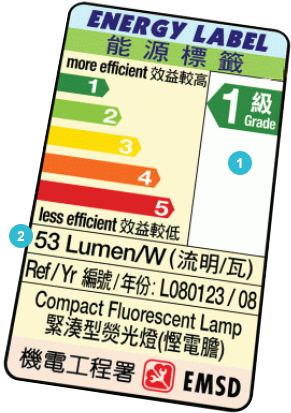
Example: Energy Efficiency Label for CFL
1Grade 1 products are most efficient (green) and have an average lamp life of 8,000 hours or above.
Grade 5 products have an average lamp life of below 6,000 hours (red).
Grade 5 products have an average lamp life of below 6,000 hours (red).
2Lamp luminous efficacy of the model. A higher number indicates that the product is more efficient.
Voluntary Energy Efficiency Labelling Scheme (VEELS) aims to encourage suppliers to take energy saving and energy efficiency into account when producing electrical appliances. The Scheme covers 22 types of household appliances, including room air conditioners (cooling capacity within 7.5-10 kW), household refrigeration appliances, washing machines (washing capacity within 7-10 kg), electric clothes dryers, electric storage water heaters, televisions, dehumidifiers (dehumidifying capacity within 35-87 L per day), electric rice-cookers, induction cookers and LED lamps, etc. The 7 types of office equipment include photocopiers, fax machines, multifunction devices, printers, LCD monitors, computers and hot/cold bottled water dispensers. Household electric appliances and office equipment are operated in two types of energy labelling system, namely, “Grading Type” and “Recognition Type”.
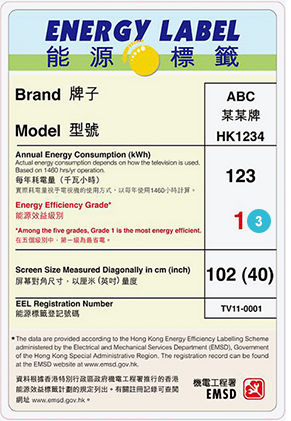
Example: “Grading Type” Energy Label
3According to the 5 energy efficiency grades:
• Grade 1 is the most energy efficient
• Grade 1 is the most energy efficient
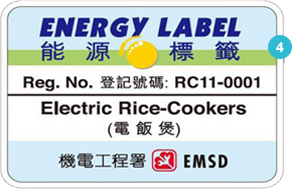
Example: “Recognition Type” Energy Label
4“Recognition Type” Energy Label indicates the product meets the minimum energy efficiency and performance requirements
In addition, the Scheme has extended to cover petrol passenger cars, in which the fuel consumption between vehicles is compared through a standard test. The “Comparison Type” Energy Label is utilized.
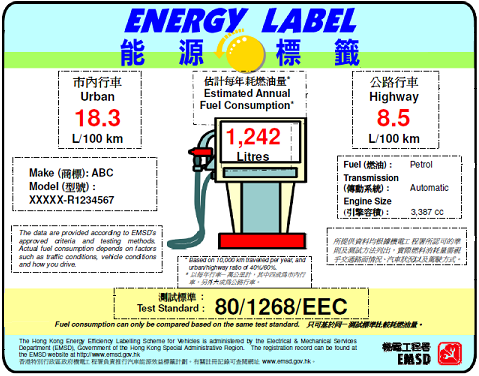
“Comparison Type” Energy Label for petrol passenger car
Mainland China
Mainland China is currently implementing a mandatory energy efficiency labelling system, targeting 15 types of products in four groups, which Grade 1 the most energy efficient and grade 5 the least.
Group 1: room air-conditioners, household refrigerators
Group 2: washing machines, unitary air-conditioners
Group 3: CFLs, High Pressure Sodium lamps (HPS), small and medium three-phase asynchronous motors, water chiller units, household instantaneous gas water heater and gas-fired heating and hot water combi-boiler
Group 4: variable speed room air-conditioners, multi-connected air-conditioning (heat pump) units, storage electric water heaters, household induction cookers, computer monitors, photocopiers
Group 2: washing machines, unitary air-conditioners
Group 3: CFLs, High Pressure Sodium lamps (HPS), small and medium three-phase asynchronous motors, water chiller units, household instantaneous gas water heater and gas-fired heating and hot water combi-boiler
Group 4: variable speed room air-conditioners, multi-connected air-conditioning (heat pump) units, storage electric water heaters, household induction cookers, computer monitors, photocopiers
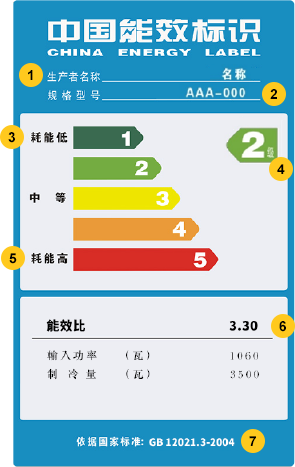
Energy Efficiency Label in Mainland China
1Responsible party, brand owner
2Product model
3High energy efficiency, low energy consumption
4Main content of the label, determined by energy efficiency standard
5Low energy efficiency, high energy consumption
6The energy consumption and main performance indexes of different products are different, which are defined based on the technical requirements specified in the energy label.
7Valid edition of current energy efficiency standard
European Union (EU)
EU’s energy labelling rating is from A to G, with A or A+++ the most energy efficient and G the least.
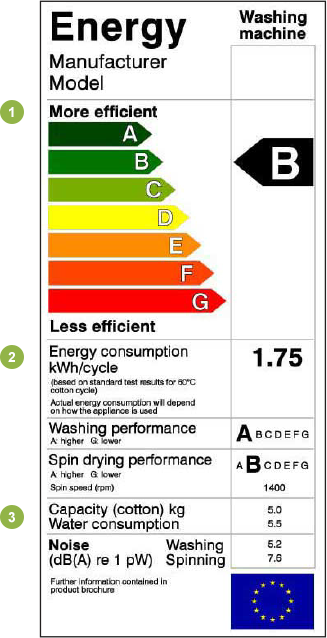
EU Energy Label
1
Energy efficiency rating
A (or A++ for fridges and freezers) is the most efficient, and G is the least efficient, based on the product’s energy consumption. 2
Energy consumption
The energy efficiency rating for each product is calculated using specific EU-defined criteria. Here, for washing machines, the rating is calculated by measuring the kilowatt hours used during a 60°C cotton cycle for a typical 6kg load. 3
Product-specific information
You’ll also find extra data related to the product, such as capacity, water consumption and noise levels.As the design and grading criteria of energy labels vary in different countries/regions, energy labels could not be compared directly. For instance, an air-conditioner with Hong Kong Energy Efficiency Label Grade 1 is equivalent to Grade 3 in Mainland China and Grade B in EU. Citizens should be aware of the actual performance indicators specified in the labels when purchasing energy efficient appliances.
